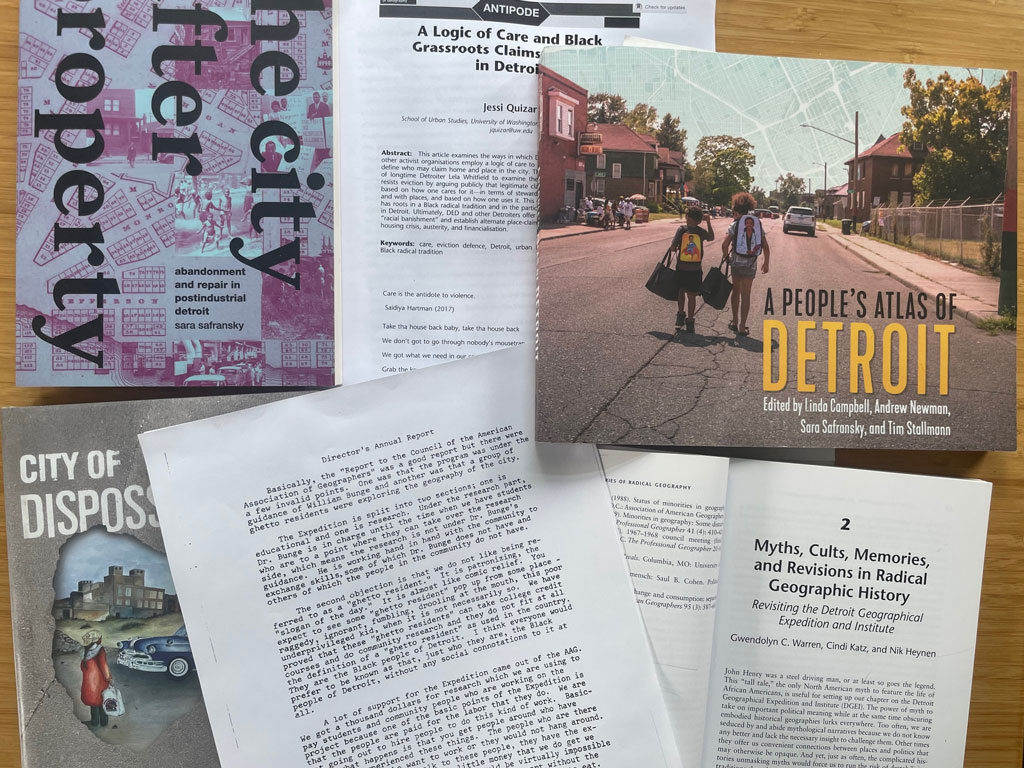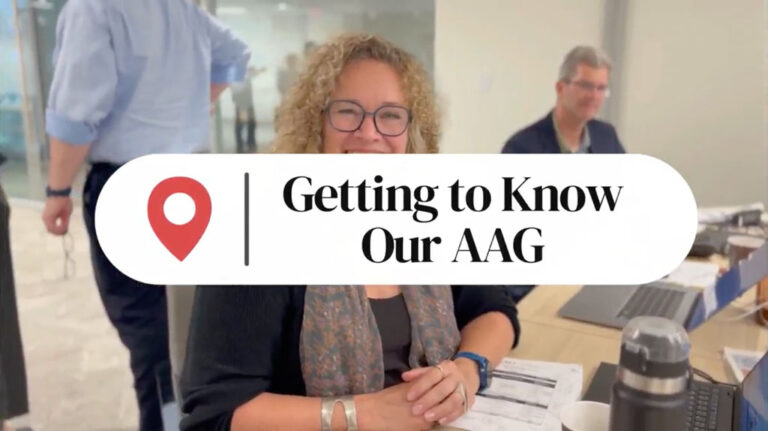Returning to Detroit: In solidarity and with care


After a 40-year hiatus, our Annual Meeting will be returning to Detroit, Michigan next March. The stack of Detroit-themed books and articles on my desk has been growing, and I am thrilled that the AAG will meet in this city again. Our long absence prompted me to briefly look back: We last met in Detroit in 1985 during the AAG presidency of Risa Palm, with 2,377 people in attendance. This may seem low given the size of more recent annual meetings, but the number of attendees amounted to roughly 44 percent of the AAG membership at the time. We were a much smaller organization then! As AAG Past President Risa Palm reminded me, the 1985 meeting was overshadowed by the University of Michigan’s decision to close their geography department only a little while earlier, which brought home the “institutional precarity of our discipline” (Huntley and Rosenblum, 2020: 367)—an ongoing concern for geography.
Like many deindustrialized cities in the U.S., Detroit has seen tremendous change since 1985, with shifts in its economic base, disinvestment, and serious population decline. In 2013, Detroit became the largest city in the US to ever declare bankruptcy. Since then, as you may know from U.S. media coverage, Detroit’s fate has changed. A recent example is the Ford corporation’s purchase and renovation of Detroit’s Michigan Central Station, which re-opened in June 2024. US media celebrate Detroit’s recent renaissance, including its renewed population growth after a decade of losses. More critical voices doubt, however, that all these new investments in the city, many of which come from outside, will benefit Detroiters. These are important concerns because “Detroit is continually rendered as a no-man’s-land and new frontier waiting to be claimed, tamed, and resettled” as Linda Campbell, Andrew Newman, Sara Safransky and Tim Stallman (2020: 11) write in A People’s Atlas of Detroit.
Our return to Detroit is in no small measure due to the advocacy of the Black Geographies Specialty Group (BGSG). As I learned during our preparations for the meeting in Detroit, BGSG urged former Executive Director Doug Richardson to hold another Annual Meeting there. “It is in the spirit of solidarity, academic intrigue, and social justice that we encourage you to select Detroit, Michigan as the host city for a future AAG Conference,” BGSG wrote in a letter[1] following the Boston AAG meeting in 2017. The letter emphasized that this majority Black city with its long history of activism and community organizing had long inspired important geographic research on race, ethnicity, and anti-Black racism–among others, the work of AAG Fellow and 2019 AAG Lifetime Achievement Award recipient Joe T. Darden.
Detroit, of course, holds a special place in the geographic imaginations of urban, radical and critical geographers because of the Detroit Geographical Expedition and Institute (DGEI), which was co-founded and co-directed by community organizer Gwendolyn Warren and geographer William (Bill) Bunge (1928-2013). DGEI operated from 1968-1972 with the goal to put geography to work in the interest of racial justice through community-based mapping and facilitating access to college education for Black Detroit youths. This work was possible with funding from the AAG. The re-release of Bunge’s book Fitzgerald: Geography of a Revolution in 2011 garnered renewed interest in the DGEI and Bunge’s work. Six sessions at the Annual Meeting in Boston in 2017 commemorated his contributions to radical geography, urban geography, and the quantitative revolution. At the 2014 AAG meeting in Tampa, two sessions focused on activist geographies and the legacies of the DGEI, including Gwendolyn Warren’s reflections in conversation with Cindi Katz (see also Warren, Katz and Heynen, 2019). This conversation challenged some of the myths in our discipline with regard to the DGEI that too often only focus on Bunge without fully understanding Warren’s role or acknowledging the important contributions of community research by “the Black people of Detroit.”
Given these complex histories, I hope that we will return to Detroit in solidarity and with care. This means “to take seriously the ways in which our work is “for others” and to build connection and responsibility as key values in our research approaches,” as AAG Past President Vicky Lawson wrote in 2007. It also means that we take seriously the city’s history and geography, and that we honor its residents’ experiences and visions for Detroit’s present and future. Recent work by geographers and others has taken on questions such as anti-eviction struggles (Quizar, 2024), property, displacement, and repair (Safransky, 2023), Indigenous and Black dispossession (Mays, 2022), and brought together community members, activists, and scholars to map and tell more nuanced stories of Detroit (Campbell, Newman, Safransky, and Stallman, 2020).
Returning to Detroit in solidarity and with care offers us an opportunity to pause and reflect on some of the historical erasures, silences, and exclusions in geography and in our professional organization, while also recognizing how much our discipline and the AAG have changed over time as we keep broadening the tent of geography. These changes are significant! I wrote about AAG’s commitment to advocacy, justice, equity, diversity, and inclusivity in my last column. But consider this: 40 years ago, there was no Black Geographies Specialty Group that could have advocated for a meeting in Detroit. Today, BGSG is a highly dynamic feature with a strong voice in the AAG and usually offers a curated track at our annual conference.
Holding a meeting in Detroit again—a city that has generated so much geographic interest and research—and returning there in solidarity and with care encourages us to make space for conversations about the future of geography, to collectively envision new geographic knowledges and practices, and—to borrow from Katherine McKittrick (2006: xv)—create more “humanly workable geographies.” To me, this is what the meeting theme–Making Spaces of Possibility–is all about. As we have been planning the meeting, solidarity and care have already provided inspiration for several special sessions that will center research on Detroit and the wider region, and honor some of the contributions to geographic knowledge that have gone unacknowledged for too long. I hope that our annual meeting in the city of Detroit will be guided by “collective care—care for land, for relationships, and for people’s well-being” (Quizar, 2024: 802).
Our planning and preparations for the Annual Meeting is putting into practice solidarity and care through AAG’s commitment to a place-based approach to Annual Meetings. This includes putting together a series of webinars on Detroit and its surrounding areas, and creating opportunities for collaboration, volunteering, and learning in and from the city and region where we meet. Registration is open. I hope to see many of you there!
[1] The letter also listed the following supporters: Drs. Joe Darden & Alan Arbogast, Michigan State University Department of Geography, the Eastern Michigan University Department of Geography and Geology, the Geographies of Food and Agriculture Specialty Group, ACME: An International Journal for Critical Geographies, Journal of Social & Cultural Geography and Feminist Liberating Our Collective Knowledge (FLOCK), UNC — Chapel Hill.
References
Campbell, L., Newman, A., Safransky, S., Stallmann, T. (eds.) (2020). A People’s Atlas of Detroit. Wayne State University Press.
Detroit Geographical Expedition and Institute (1971). Available at https://antipodeonline.org/wp-content/uploads/2017/01/dgei_fieldnotes-iii_b.pdf.
Huntley, E. R., & Rosenblum, M. (2020). The Omega affair: Discontinuing the University of Michigan Department of Geography (1975–1982). Annals of the American Association of Geographers, 111(2), 364-384. https://doi.org/10.1080/24694452.2020.1760780#d1e244
Lawson, V. (2007). Geographies of Care and Responsibility. Annals of the Association of American Geographers, 97(1), 1-11. https://doi.org/10.1111/j.1467-8306.2007.00520.x
Mays, K. T. (2022). City of Dispossessions: Indigenous Peoples, African Americans, and the Creation of Modern Detroit. University of Pennsylvania Press.
McKittrick, K. (2006). Demonic Grounds. Black Women and the Cartographies of Struggle. University of Minnesota Press.
Quizar, J. (2024). A Logic of Care and Black Grassroots Claims to Home in Detroit. Antipode, 56(3), 801-820.
Safransky, S. (2023). The City after Property: Abandonment and Repair in Postindustrial Detroit. Duke University Press.
Warren, G. C., Katz, C., & Heynen, N. (2019). Myths, Cults, Memories, and Revisions in Radical Geographic History: Revisiting the Detroit Geographical Expedition and Institute. Spatial Histories of Radical Geography: North America and Beyond, eds. T.J. Barnes and E. Sheppard, Wiley: 59-85.
Please note: The ideas expressed in the AAG President’s column are not necessarily the views of the AAG as a whole. This column is traditionally a space in which the president may talk about their views or focus during their tenure as president of AAG, or spotlight their areas of professional work. Please feel free to email the president directly at P.Ehrkamp@uky.edu to enable a constructive discussion.


